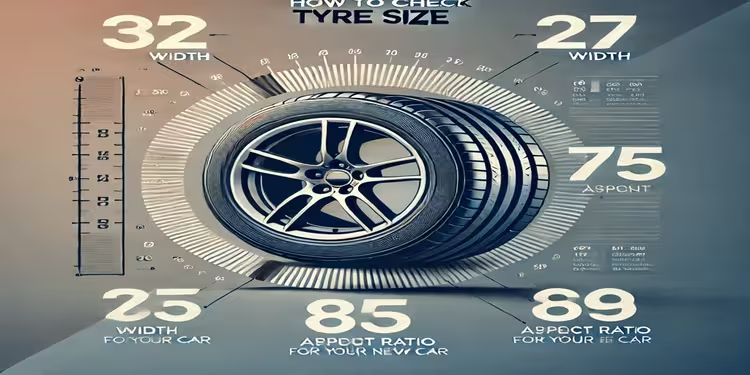

Tyres are crucial to any vehicle, impacting safety, performance, and comfort. Knowing how to check the tyre size is essential if you've recently bought a new car. Whether replacing tyres or simply curious, understanding tyre sizes can save you time and money.
Let's break it down step by step.
Tyre size refers to a standard series of numbers and letters printed on the tyre's sidewall. These markings indicate the tyre’s dimensions, capabilities, and specifications. Knowing these details ensures you pick the right tyre for your new car, balancing performance and safety.
Also Read:- How to Find Chassis Number
Below, are some of the factors that clearly defines why having a correct tyre size of the car is important:
Ensures Safety: The correct tyre size maintains proper handling and braking.
Improves Performance: Right-sized tyres optimize fuel efficiency and grip.
Prevents Damage: Mismatched tyres can wear out faster, costing more in the long run.
Enhances Comfort: Properly sized tyres contribute to a smoother driving experience, reducing road noise and vibrations.
Increases Longevity: Correct tyre sizes reduce the risk of uneven wear, extending the life of your tyres.
Also Read:- How to Find VIN Number
Enhanced Safety: Proper-sized tyres ensure stability and control.
Better Fuel Efficiency: Correct tyres reduce rolling resistance, improving mileage.
Longer Lifespan: Matching the right size prevents unnecessary wear and tear.
Improved Comfort: Right-sized tyres offer a smoother driving experience.
Optimised Handling: Correct tyres provide better grip and manoeuvrability in all driving conditions.
Cost Savings: Using the right tyre size reduces the likelihood of premature wear, saving on replacement costs.
Also Read:- How to Renew PUC Online
The following few steps will ease your accessibility to check tyre size:
Every tyre has its size imprinted on the sidewall. These markings may appear confusing at first but are simple to decode. Here’s an example:
205/55 R16 91V
Let’s break down the above example:
205: This is the tyre’s width in millimetres, measured from sidewall to sidewall.
55: This number indicates the aspect ratio, representing the height of the tyre’s sidewall as a percentage of its width. Here, the height is 55% of the width.
R: This stands for Radial construction, the most common type of tyre.
16: This refers to the diameter of the wheel rim, measured in inches.
91V: These numbers and letters denote the load index and speed rating, respectively.
If the sidewall markings seem unclear, refer to your car’s owner's manual. It provides specific tyre size recommendations suited for your vehicle. Look for the “tyre and loading” section to find exact details.
Most new cars have a tyre information sticker located on the driver’s door jamb. This label includes details such as recommended tyre size, pressure, and load capacity.
Pro Tip: Always check this label when considering tyre replacements to ensure accuracy.
Several websites and apps allow you to input your car’s make and model to determine the correct tyre size. This is a quick and convenient option if you’re away from your vehicle. Popular tools include manufacturer websites and dedicated tyre retailer platforms.
Also Read:- How to Protect your Car in Winters
The load index indicates weight potential each tyre can support. Ensure the load index matches the requirements of your new car to avoid overloading and potential tyre failure.
The speed rating defines the maximum speed a tyre can handle safely. For instance, the letter “V” in our earlier example means the tyre can handle speeds up to 240 km/h. Always choose tyres with a speed rating that suits your driving style.
If you live in areas with extreme weather conditions, consider checking the tyre size for all-season, summer, or winter tyres. These specialised tyres often have specific markings indicating their suitability.
Here are some of the smart tips that will surely help you in selecting the right tyres for your car. Give a quick look at them:
Always adhere to the tyre size specified by the car manufacturer. Using inappropriate sizes may compromise safety and performance.
Ensure all four tyres have the same size and specifications. Mixed sizes can lead to uneven wear and affect handling.
For city driving, standard tyres work best. For off-roading or snowy conditions, look for specialised tyres.
The load index indicates how much weight a tyre can carry, while the speed rating determines the maximum speed it can sustain. Both factors are critical for safe driving.
Premium tyre brands often offer better durability, performance, and warranty options. While they may cost more upfront, they can save money over time by lasting longer.
Avoid making mistakes while choosing the tyre size of your new car. Some of the common mistakes that individuals make are:
Relying solely on visual size estimation can lead to incorrect purchases. Always check the printed size.
Using different-sized tyres may lead to imbalance and unsafe driving conditions.
Don’t forget to check the spare tyre size to ensure it matches the other tyres. Having a mismatched spare can create complications in emergencies.
If you're unsure about the right tyre size, consult a professional. They can provide expert recommendations based on your car’s requirements and your driving habits.
Understanding how to check tyre size for your new car is a straightforward yet vital task. By paying attention to tyre markings, consulting your car manual, or using online tools, you can make informed choices that ensure safety and performance. Always stick to manufacturer recommendations and avoid common mistakes to keep your vehicle running smoothly.
Taking the time to check your tyre size today can prevent future hassles and ensure a safer, more comfortable driving experience. Don’t wait until it’s too late—inspect your tyres now and drive with confidence!